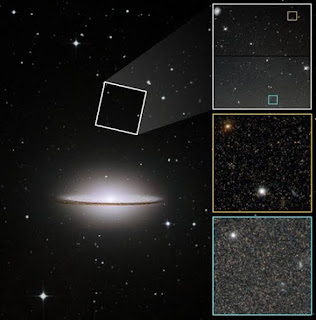National Aeronautics and Space Administration (NASA) was able to capture the glow within three days using the Hubble Space Telescope but the results were baffling.
On the left is an image of the Sombrero galaxy, and on the right side shows the detail in which Hubble was able to capture of the stars in the halo.SciTech News: Astronomers found a unique celestial event as they found the brightest infrared from a short gamma-ray burst ever seen. the rationale why it's so important is because of the glow produced is brighter than what was previously considered as maximum. The half-a-second flash of light from a very violent explosion was detected earlier this year in May. The energy was produced by the explosion of gamma rays billions of light-years faraway from earth which contains more energy than what our Sun will produce in its lifetime.
“It’s amazing to me that after 10 years of studying the same type of phenomenon, we can discover unprecedented behaviour like this,” said Wen-fai Fong, assistant professor of physics and astronomy at Northwestern University and lead author of the study. “It just reveals the diversity of explosions that the universe is capable of producing, which is very exciting.”
National Aeronautics and Space Administration (NASA) was able to spot the glow within three days using the Hubble Space Telescope. However, the results were baffling because it was 10 times brighter than the earlier prediction.
“These observations don't fit traditional explanations for brief gamma-ray bursts,” said Fong. “Given what we all know about the radio and X-rays from this blast, it just doesn’t match up. The near-infrared emission that we’re finding with Hubble is much too bright.”
In order to know the exact levels of brightness and therefore the distance of the origin, WM Keck Observatory on mauna kea in Hawaii was used by the team.
Scientists believe that explosions like these are caused by two merging neutron stars which cause short gamma ray bursts which will create immense levels of energy. This phenomenon is named Kilonova. These stars are dense to an extent that even a teaspoon of it on Earth can weigh a billion tons. Typically, it's the mass of our Sun compressed into a small city.
“What we detected even outshines the one confirmed kilonova discovered in 2017,” said co-author Jillian Rastinejad, a graduate student with Fong’s team at Northwestern University. “As a first-year graduate student working with real-time data for the first time when this burst happened, it’s remarkable to see our discovery motivate a new and exciting magnetar-boosted model.”
In the future, these events are often recorded better with NASA’s upcoming James Webb Space Telescope which will help scientists understand them better.
“Distances are important in calculating the burst’s true brightness as opposed to its apparent brightness as seen from Earth,” said Fong. “Just as the brightness of a light bulb when it reaches your eye depends on both its luminosity and its distance from you, a burst could be really bright because either it is intrinsically luminous and distant, or not as luminous but much closer to us. With Keck, we were able to determine the true brightness of the burst and thus the energy scale. We found it was to be much more energetic than we originally thought.”
Also Read|
SpaceX launches 4 astronauts to space station, beginning new era for NASA
Massive Asteroid 'Apophis',May Hit Earth in 2068,We have no solution,says Elon Musk

No comments:
Post a Comment